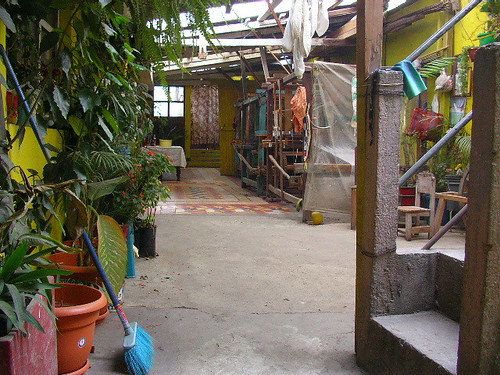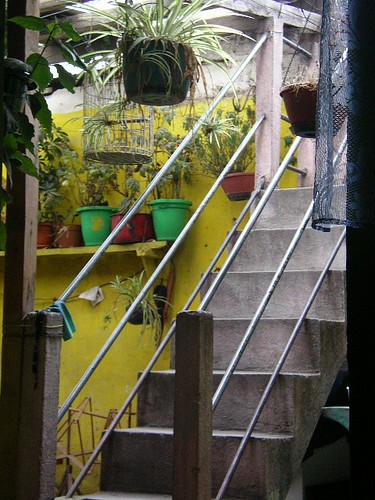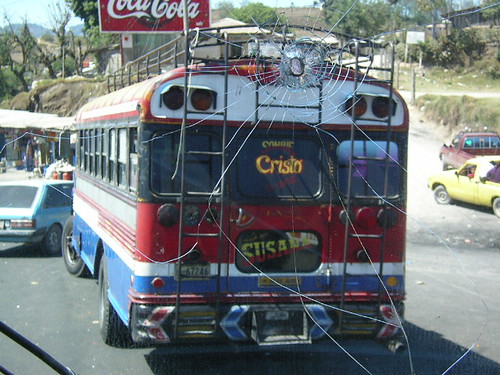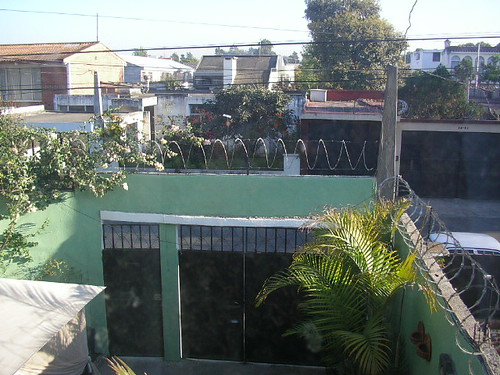I said goodbye and got my diploma from Juan Sisay last week, and started with a new school and new home in Xela this week. It just felt like time for a change, and I made it up the waiting list into what seems to be the most prestigious school in Xela, El Proyecto Linguistico Quetzalteco. The teachers here are primarily middle-aged women, as opposed to primarily young men at Juan Sisay, and the atmosphere is much more professional and mature. Not that Juan Sisay was that bad, but there was definitely a noticable amount of juvenile machismo around, at least if you went to any of the school parties.
On my first day at the Proyecto, they had an orientation which included a political history of Guatemala and a documentary film (all in English) of a narrative of an indigenous Guatemalan woman who escaped alone from the massacre of her entire village during the civil war when she was 8 years old, and later adopted by an American family. During the film she returned to the former site of her village, found relatives still living in the Guatemalan countryside, observed the exhumation of the mass grave, and testified before a genocide hearing (the actions of the Guatemalan government during the civil war have since been officially labeled as genocidal by the UN). The film brought tears to my eyes, which is very rare for me - there´s something about being here which makes knowledge of the country's history so much more real. It should be noted that the civil war here started in 1960 after a CIA-organized and funded coup overthrew a democratically elected government in favour of a military dictatorship, and US military supplying and training of the government continued throughout the 36-year civil war. Primarily for the sake of the United Fruit Company (since purchased by Del Monte), and bananas, because the democratic leftist government in the 50's began forcibly buying land from the UFC at declared tax-value and returning it to campesinos (peasants). During the war hundreds of entire indigenous villages were massacred (men, women, children, and domesticated animals), because they were believed to be potential sources of guerrilla rebels. I could go on, and perhaps will again later.
Both schools have interesting conferences which I must talk about more when I have time, but the first two at the Proyecto have been especially interesting. This morning an ex-guerrilla from the civil war came in and told us stories about hiding in the mountains and fighting against the army. I wish I could have understood better, but I picked up parts about being in a group of 4, separated by the army from the rest of his group of 90 geurrillas and going for days without food until he found his way back to a camp. He spent 5 years as a geurrilla, fighting in the mountains.
Monday, someone gave a conference about the TLC, Tratado de Libre Comercio, or Central American Free Trade Agreement. The Guatemalan congress just ratified it last week, and there have been protests since then stopping highway traffic around the country. Most of the reasons he gave for people opposing the agreement were familiar to me - it's an agreement between each central american country individually with the US, fears that Guatemalan companies won't be able to compete against large US corporations without protection, industries in which Guatemala would have an advantage (like sugar) are not being fully opened up, and fears of further conglomeration of land holdings by large corporations. I learned a new one though: Guatemala will be forced to accept imports of genetically modified corn seeds and products. This is very troubling for a lot of indigenous Guatemalans, whose primary food is corn and whose most accepted creation story (told in the book Pop Whuj) says that their people were literally made of maiz (corn) and they are decendants of the maiz. Perhaps you can imagine then the repercussions of eating a corn whose essence has been modified by the colonists. That's a concern against GMOs that I was never told about in school. Indigenous activist groups have been active in the anti-free trade protests, however even though they form a majority of the population, most live in the countryside and don't vote, and are not such a big a political force. Only 33% of the eligible population voted in the last national elections, which was a race between the neoliberal winner who ratified the free trade agreement, and an ex-general who many consider to be a war criminal.
On a completely different note, although it was very sad to leave my last place, my new home is wonderful. I'm living with a single mother (Lila) the same age as me, her 12-year-old daughter Maria-José, and her 70-year old mother who is visiting right now because she´s sick. I have a key to the home and Lila lets me help around the house and do the dishes, both of which help me feel more at home than my last place. I have lots of opportunity to speak Spanish at home and watch cartoons with Marie-José, which is great for my Spanish. Lila is teaching me how to make corn tortillas by hand which I am absolutely thrilled about. As you might imagine, it is not easy to form a perfectly circular tortilla with even thickness, using only your two hands. One day though I will, after a lot of practice. I'll sign off with a quick vignette about the corn tortillas here:
Maiz tortillas and tamales are the staple food of the indigenous population of Guatemala. In the city particularly there are many modern foods also in the diet now, but maiz is still the staple. I've been told that a hard-working campesino will eat a stack of tortillas, oh, 20cm (9") high every day. The tortillas here are unbelievably delicious, and can be purchased hot off the griddle in tortillerias all over the city, 5 or 6 for Q1 (CDN$0.17). When making them from dried corn by hand, the corn must first be boiled and agitated to remove the skin. However the skin will not come off, unless you add the mud of a white rock called "cal." As it turns out, cal rock is rich in calcium, and several people have now told me that for this reason, osteoporosis is almost unheard of in the indigenous population of Guatemala. I find is so remarkable that thousands of years ago, someone figured out that the mud obtained from dissolving this particular rock could help in making maiz dough, and that furthermore it became an ideal source of calcium.
OK, that´s all for now. This weekend, including Friday, is a national holiday called Semana Santa and most everything will be closed, so I likely won't be able to access any internet cafes. I have more photos to post next time though, including photos of the kids I've been tutoring and of my first family.









